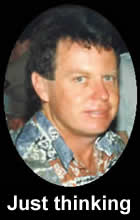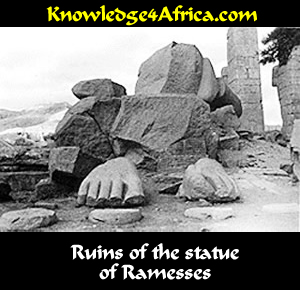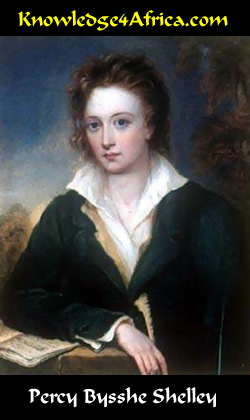|
READ THIS
A traveller has told the poet of a broken statue of a great pharaoh which lies half-buried in the desert
sands of Egypt. It reminded the traveller of how the mighty have fallen, how a great pharaoh -- who
believed himself invincible -- has become but a distant memory whose statue even has fallen into decay
and ruin.
 A NOTE ON THE POET
A NOTE ON THE POET
Percy Bysshe Shelley was born in Sussex in August 1792. He was from an aristocratic family, his father
being a squire and a member of Parliament.
The young Shelley was educated at Eton College and then proceeded to Oxford University but was soon
expelled for publishing an article promoting atheism.
Within a couple of years, the poet eloped with Harriet Westbrook, a working-class teenager. The
marriage, however, was a failure.
He then hitched up with Mary Godwin, daughter of a philosopher and anarchist. She was of a more
literary disposition.
Harriet in the meantime drowned herself which cleared the way for the poet to marry his new love. As
Mary Shelley, she herself would become famous for her novel Frankenstein.

Shelley wrote "Ozymandias" in 1817 when interest in Egyptology was growing. The poet had just
visited the British Museum where he had seen the recently acquired Rosetta Stone, as well as a statue
of Pharaoh Rameses II.
The boast "My name is Ozymandias, King of Kings" comes from Diodorus Siculus's description of
the several monuments to Rameses II. The quote had then appeared in several travel books of the time.
Shelley drowned in 1822 when his small schooner struck a rock and sank. He was only thirty years
of age. His body washed ashore at Viareggio where it was burned on the beach. His ashes were later
buried in Rome.
He is remembered as one of the most successful of the Romantic poets.
Have you looked at the questions
in the right column?
|
TEST YOURSELF!
Read the left column and then answer
the following questions:
"And on the pedestal these words appear:
'My name is Ozymandias, king of kings:
Look on my works, ye Mighty, and despair!' "
- Comment on the IRONY of the pharaoh's words, "Look on my works, ye Mighty, and
despair!" (4)

[Need help?]
The pharaoh, in his arrogance, believed that he was the greatest of rulers -- the "king of kings".
His works -- public buildings, statues, etc -- were so great that everyone would cower in fear when they
observed them. The irony, however, is that these great works have collapsed and lie in ruins everywhere,
and few can even remember who Rameses II was. Such is the fate of the great tyrants.
|
- To whom is Ozymandias referring he speaks of "ye Mighty"? Why should they
"despair"? (4)

[Need help?]
Ozymandias is presumably referring to all his enemies. They would despair -- cower in fear -- at the
sight of all the wonderful public works that had been erected in the pharaoh's name and in his honour.
As soon they saw these statues and monuments, they would know that such great works would indicate
a truly powerful ruler. They would then tremble in fear at what he would do to them and their puny armies.
|
- Why should Ozymandias refer to himself as "King of Kings"? (2)

[Need help?]
"King of Kings" would mean "the greatest of all kings". Ozymandias considered himself so
powerful that he believed himself to be the greatest ruler that the world had ever seen.
|
"Nothing beside remains. Round the decay
Of that colossal wreck, boundless and bare
The lone and level sands stretch far away."
- What does the poet mean when he says that "Nothing beside remains"? (4)

[Need help?]
The poet probably means "nothing else remains". In other words, everything lies in ruins and there
is nothing else but the encroaching sand of the desert.
|
- Comment on these words as a conclusion to the sonnet. (4)

[Need help?]
Notice how the poet stresses the decay of the wreckage. The desert has encroached and destroyed even
the last symbols of the pharoah's power. The desert stretches as far as the eye can see. It is so vast that
it has no boundaries ("boundless") and nothing grows there ("bare").
The sand is devoid of vegetation and of people ("lone"). This was once a populated land during
the time of the pharaoh, otherwise why would he have had his statue erected at this point? And yet even
the symbols of the pharaoh's power are vanishing.
|
GENERAL QUESTIONS:
- What is the theme of the Octave? (4)

[Need help?]
The Octave describes what the traveller saw: the ruins of the ancient statue of Ozymandias. He
describes the characteristics of the statue, the frown, the outstretched hand, etc.
|
- What is the theme of the Sestet? (4)

[Need help?]
The Sestet dwells on the irony of the downfall of tyranny. The great pharaoh, who believed he ruled the
entire world, is now dead and long forgotten so that even his statue lies in ruins, sinking into the desert
sand.
|
- What type of sonnet is this? Remember to give reasons for your answer. (6)

[Need help?]
Ostensibly it is an Italian or Petrarchan sonnet with an Octave and a Sestet, each with their own themes.
The rhyming scheme, however, is somewhat out of the ordinary. A normal Petrarchan sonnet would have
a scheme something like:
abab cdcd
efg efg OR efefef
This sonnet, however, has a variation:
abab cded
fgf hgh
|
|




